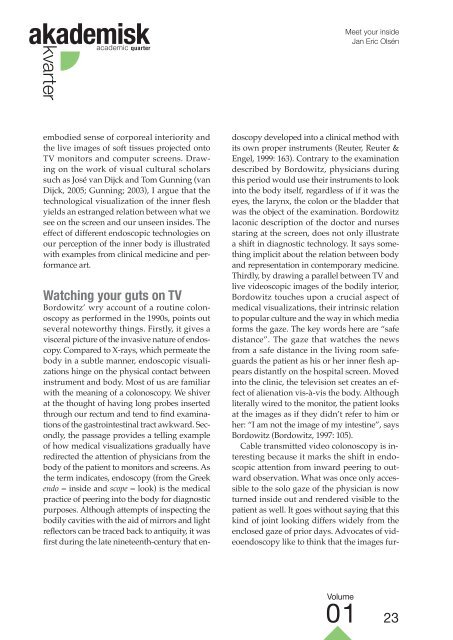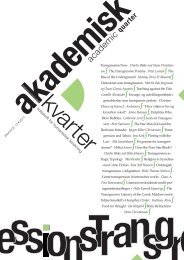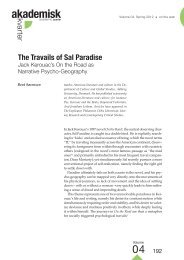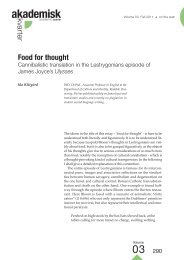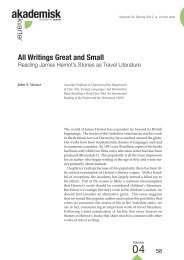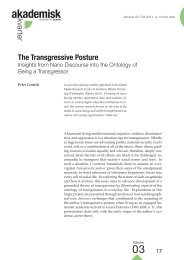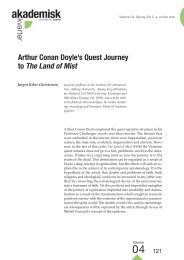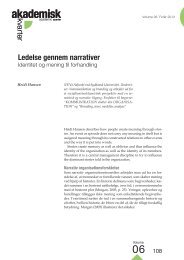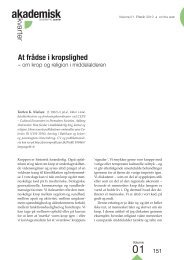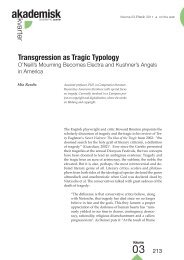Academic Quarter - Akademisk kvarter
Academic Quarter - Akademisk kvarter
Academic Quarter - Akademisk kvarter
You also want an ePaper? Increase the reach of your titles
YUMPU automatically turns print PDFs into web optimized ePapers that Google loves.
akademiskacademic quarter<strong>kvarter</strong>Meet your insideJan Eric Olsénembodied sense of corporeal interiority andthe live images of soft tissues projected ontoTV monitors and computer screens. Drawingon the work of visual cultural scholarssuch as José van Dijck and Tom Gunning (vanDijck, 2005; Gunning; 2003), I argue that thetechnological visualization of the inner fleshyields an estranged relation between what wesee on the screen and our unseen insides. Theeffect of different endoscopic technologies onour perception of the inner body is illustratedwith examples from clinical medicine and performanceart.Watching your guts on TVBordowitz’ wry account of a routine colonoscopyas performed in the 1990s, points outseveral noteworthy things. Firstly, it gives avisceral picture of the invasive nature of endoscopy.Compared to X-rays, which permeate thebody in a subtle manner, endoscopic visualizationshinge on the physical contact betweeninstrument and body. Most of us are familiarwith the meaning of a colonoscopy. We shiverat the thought of having long probes insertedthrough our rectum and tend to find examinationsof the gastrointestinal tract awkward. Secondly,the passage provides a telling exampleof how medical visualizations gradually haveredirected the attention of physicians from thebody of the patient to monitors and screens. Asthe term indicates, endoscopy (from the Greekendo = inside and scope = look) is the medicalpractice of peering into the body for diagnosticpurposes. Although attempts of inspecting thebodily cavities with the aid of mirrors and lightreflectors can be traced back to antiquity, it wasfirst during the late nineteenth-century that endoscopydeveloped into a clinical method withits own proper instruments (Reuter, Reuter &Engel, 1999: 163). Contrary to the examinationdescribed by Bordowitz, physicians duringthis period would use their instruments to lookinto the body itself, regardless of if it was theeyes, the larynx, the colon or the bladder thatwas the object of the examination. Bordowitzlaconic description of the doctor and nursesstaring at the screen, does not only illustratea shift in diagnostic technology. It says somethingimplicit about the relation between bodyand representation in contemporary medicine.Thirdly, by drawing a parallel between TV andlive videoscopic images of the bodily interior,Bordowitz touches upon a crucial aspect ofmedical visualizations, their intrinsic relationto popular culture and the way in which mediaforms the gaze. The key words here are “safedistance”. The gaze that watches the newsfrom a safe distance in the living room safeguardsthe patient as his or her inner flesh appearsdistantly on the hospital screen. Movedinto the clinic, the television set creates an effectof alienation vis-à-vis the body. Althoughliterally wired to the monitor, the patient looksat the images as if they didn’t refer to him orher: “I am not the image of my intestine”, saysBordowitz (Bordowitz, 1997: 105).Cable transmitted video colonoscopy is interestingbecause it marks the shift in endoscopicattention from inward peering to outwardobservation. What was once only accessibleto the solo gaze of the physician is nowturned inside out and rendered visible to thepatient as well. It goes without saying that thiskind of joint looking differs widely from theenclosed gaze of prior days. Advocates of videoendoscopylike to think that the images fur-Volume01 23


